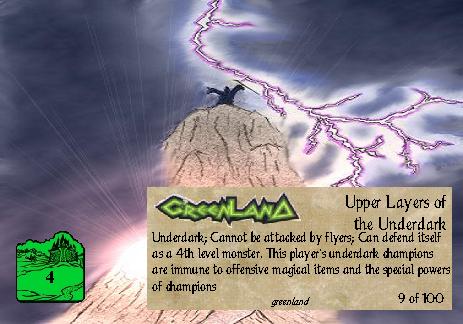3. Upper Caverns

3. Upper Caverns

|
|
|
|
|
|
|
|
|
|
|
|
Geography: This is the central area of a vast network of limestone
caves.
These are living caves, and water is plentiful
throughout the area. None of the caves are totally filled with
water, although occasional pools are six to eight feet deep. In several
locations, dungeons have been excavated from the caves,
although none of the excavated areas is larger than 300 feet
square.
The area is a virtual maze of twisting, winding caverns. Cliffs,
chasms, and constricting passages are very common. The largest
chamber in the whole area is not more than 20 feet wide, 10
feet high, and 100 feet long. Each end of this cavern is pinched
off by a narrow continuation of the cavern that is about three feet
high and two feet wide. These small tunnels are typical of the
area.
The caverns entering from the hill region often lead directly into
this cave network. Several longer tunnels, mostly of natural origin,
lead to exits at dwarven mine shafts in the mountains. The
tunnel leading to the lake ends in a watery wall; only the permanent
effects of a wall of force prevent the water from flooding
much of the area.
Denizens: Because of its relatively easy access to the surface
world, this part of Deepearth is inhabited by creatures that like to
leave their subterranean lairs to raid human settlements on the
surface. Each raiding band has gained control of a small section
of caverns, and usually is centered in an excavated area of
dungeon corridors and rooms. Among the races holding
parts of
this area are troglodytes, goblins,
hobgoblins, ogres, trolls, and
lycanthropes. Although the individual members of these races
fight each other at the slightest provocation, their communities
manage to coexist relatively peacefully.
Additionally, a great number of unintelligent monsters roam the
passages of this area. These include giant rats, bats, carrion
crawlers, and other scavengers, as well as a few potent individual
monsters such as a gibbering mouther, a greater basilisk, and a
shambling mound.
A beholder also wanders among these tunnels, taking whatever
it wants from anything it encounters. The beholder is the
most powerful monster in the area, and all others give it a wide
berth.
Resources: This area has plentiful supplies of air &&
water.
No evidence of any kind of mineral wealth can be found. A variety
of underground plants, including lichens, molds, and fungi, provide
the basic element in the food chain.
Unique Features: The troglodytes
control the largest collection of dungeon and cavern areas.
In the center of their holdings they have cleared a large, circular
amphitheater that is about 80
feet in diameter. In its center, they have erected a large, fungus-covered
statue that seems vaguely humanoid. They worship this
statue as their deity, although it is in fact a quite unremarkable
sculpture of a human war hero. Each eye of the statue, however,
holds a massive diamond (worth 10,000 gp each). These diamonds
are completely covered by the fungus that spreads over
the entire statue.
One of the pools in the AREA has some special properties. It is
only three feet wide and one foot deep. Water drips slowly into it
from a stalactite at the rate of one pint per year. The water somehow
gains an enchantment during this process-becoming a
potion of infravision. A character without infravision who drinks a
pint of the water gains the ability with a 60-foot range, and retains
it for a period of 2d6 weeks. Characters with infravision who drink
the water lose the ability for a similar amount of time. There are
30 pints of water in the pool. If stored in an airtight container,
it will
keep indefinitely.